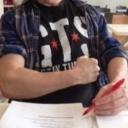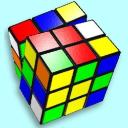Yahoo Answers จะปิดใช้งานในวันที่ 4 พฤษภาคม 2021 (เวลาตะวันออก) และตอนนี้เว็บไซต์ Yahoo Answers จะอยู่ในโหมดอ่านอย่างเดียว คุณสมบัติหรือบริการอื่นๆ ของ Yahoo หรือบัญชี Yahoo ของคุณจะไม่มีการเปลี่ยนแปลงใดๆ คุณสามารถค้นหาข้อมูลเพิ่มเติมเกี่ยวกับการปิดใช้งาน Yahoo Answers และวิธีการดาวน์โหลดข้อมูลของคุณในหน้าความช่วยเหลือนี้
A trigonometrical problem:?
If a,b,c are the 3 sides of triangle ABC; r is the radius of the
circumcircle; S is the area of ABC. Prove that r=abc/(4S). Help.
6 คำตอบ
- ?Lv 74 เดือน ที่ผ่านมาคำตอบที่โปรดปราน
The marked angles are equal by the Inscribed Angle Theorem.
(https://en.wikipedia.org/wiki/Inscribed_angle)
Note that by similar triangles,
h . . . c/2
--- = -------.................................. (1)
b. . . . . r
Thus, the area of the triangle is
S = ah/2 = a*b*c/4 r......................(2)
Therefore, the circum-radius is
r = a b c/ 4 S...................................(3) ................... Proved

- PinkgreenLv 74 เดือน ที่ผ่านมา
My way:
the sine rule gives
a/sinA=b/sinB=c/sinC=2r
=>
(a+b+c)/2=r(sinA+sinB+sinC)
=>
s=r(2S/bc+2S/ac+2S/ab),
where
[s=(a+b+c)/2 &
S=absinC/2=bcsinA/2=casinB/2;
sinA=2S/bc,sinB=2S/ac,sinC=2S/ab]
=>
s=2rS(1/bc+1/ac+1/ab)
=>
s=2rS(a+b+c)/abc
=>
s=4rSs/abc
=>
r=abc/(4S).
- charlatanLv 74 เดือน ที่ผ่านมา
this is a type of problem which confuses a student.
suppose
area of the triangle = S sq.cm
radius of the circumcircle = R cm
how can length and area be equal?
though numerically same, units are different.
all that has been achieved is manipulation of
the numbers.
- atsuoLv 64 เดือน ที่ผ่านมา
We want to prove r = abc/(4S).
S is the area of △ABC (BC = a, AC = b, AB = c), so
S = (1/2)ab*sin(∠ACB).
Let the center of the circle be O.
∠ACB = ∠AOB/2, so
S = (1/2)ab*sin(∠AOB/2)
sin(∠AOB/2) can not be negative, so
sin(∠AOB/2) = √[1 - cos^2(∠AOB/2)]
We know cos(2θ) = 2cos^2(θ) - 1 so cos^2(θ) = (cos(2θ) + 1)/2.
Therefore
sin(∠AOB/2) = √[1 - (cos(∠AOB) + 1)/2]
= √[1/2 - cos(∠AOB)/2]
So
S = (1/2)ab√[1/2 - cos(∠AOB)/2]
Think △AOB. AO = BO = r and AB = c, so by the cosine law,
c^2 = r^2 + r^2 - 2r^2*cos(∠AOB)
cos(∠AOB) = (2r^2 - c^2)/(2r^2)
= 1 - c^2/(2r^2)
So
S = (1/2)ab√[1/2 - (1 - c^2/(2r^2))/2]
= (1/2)ab√[c^2/(4r^2)]
= (1/2)ab(c/(2r))
= abc/(4r)
Therefore
abc/(4S) = abc/(abc/r) = r
- rotchmLv 74 เดือน ที่ผ่านมา
This is how I did it: consider it the other way around ;)
Via scaling, consider the unit circle. WLOG, Let A = (1,0). B & C the other two points.
Now your problem becomes a simple two parameter system: B = (d, √(1-d²)) and C = (e, √(1-e²)). Using pythagora, areas (all basic geometry) your result follows after a little algebra...
- PuzzlingLv 74 เดือน ที่ผ่านมา
The center, O, of the circumcircle is equidistant from all 3 vertices.
Given:
BC = a
AC = b
AB = c
OA = OB = OC = r
Draw a diameter BD that goes through O.
OD = r
BD = 2r
Also drop a perpendicular BE from B down to AC.
BE = h
∠BEC is a right angle by the definition of perpendicular.
∠BAD is a right angle by Thales' Theorem (BD is a diameter)
∠ADB and ∠BCA subtend the same arc AB, so they are congruent.
By the AA Similarity Postulate, △BAD ~ △BEC.
Corresponding parts of those triangles are proportional so:
BD/BA = BC/BE
Substituting we have:
2r/c = a/h
The area S, of △ABC is:
S = bh/2
Solving for h:
h = 2S/b
Substituting for h:
2r/c = a / (2S/b)
2r/c = ab / (2S)
Solving for r:
r = ab / (2S) * c/2
r = abc / (2*2S)
r = abc / (4S)
Q.E.D.







